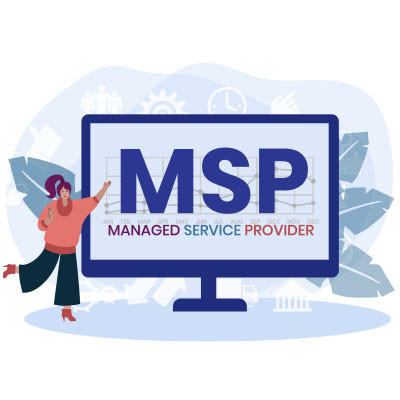There's a lot of pressure on (often understaffed and overworked) internal IT teams to manage and maintain increasingly complex systems. For businesses noticing signs of strain on their IT staff, seeking assistance from managed services providers (MSPs) could be the remedy. Here's how an MSP like us can alleviate the pressure and contribute to workplace wellness for all.
EZ MSP Blog
Do you have employees who struggle with their technology? Chances are that there will always be individuals who are not as proficient with it as you might expect, and without a dedicated IT resource to ask for assistance, they might get frustrated and disengage with their work. You need to provide the right support to your employees, and you’re in luck; we have just the right solution to your problems: a help desk!
Cost/Benefit is a term you hear a lot. It’s always used in conversations about potential investment and means something. Well, at least it should. One of the places that many people can gain benefits from their investments is by outsourcing some of their responsibilities to an outside vendor. This works especially well with IT management. Let’s take a look at why outsourcing your technology support and management is a good investment.
It’s an unfortunate fact that all businesses will inherently face some threats during their operations. That’s inescapable. From cyberattacks to natural disasters to good, old-fashioned accidents, you’re liable to face no small risk. This risk makes a process known as risk mitigation so critical for all businesses to undergo with some regularity.
Let’s review a few aspects of creating and maintaining a dependable risk mitigation strategy.
This goes out to all the business owners, managers, department heads, and other leaders in the workplace who have to field user complaints and issues.
Being in this position can be hard, because you often have to say no. No, we can’t change the timeline or increase the budget for this project. No, we can’t do XYZ that way because it would break compliance. No, we can’t get new hardware/software in until we get it approved in the budget. Repeat ad nauseam.
A company’s IT strategy can define how it handles its entire operational strategy. That’s why it is so important to carefully consider your organizational approach to IT. Not only does it allow you to align your IT, and its support, to your business’ goals, but it also allows you to consider the circumstances that you operate under and find viable solutions to business problems. That’s not all. Let’s list some of the reasons that businesses should consider customizing their IT strategy to their business initiatives.
Many businesses, irrespective of their size, are increasingly turning towards managed services to streamline their operations, reduce expenses, and elevate their overall customer value proposition. The utilization of managed services has revolutionized the landscape, not just in terms of cost-saving, but also in facilitating businesses to grow and extract greater value from their IT infrastructure. Let's take a look into how managed services achieve this dual objective.
Businesses use all types of sayings to try to draw in customers. One of the core selling points of managed IT services is that “it pays for itself”. This is more than just marketing. The multiple services that make up managed IT services all help a business save time and money, but when added together, it can really help the bottom line of a business more than most services they can use. In this week’s blog we thought we would go through the core elements of a managed IT services agreement to show how it really does pay for itself.
Cloud computing has been touted as one of the most innovative and important technologies for smaller businesses as they look to compete with larger organizations. How it makes this possible is by offering dynamic computing environments that can help bring these smaller businesses into the information age without saddling them with massive infrastructure costs while doing so. That’s not to say that the cloud is cheap by any means, and this month we will discuss how cloud computing is a great option for nearly any business.
How does your business manage its IT? Do you have an in-house team, and how busy are they with all of the hustle and bustle of their everyday duties? Do they have time to address the many challenges and requests made of them? If not, then perhaps you should consider a different model for your IT management. Luckily, we have just the opportunity for you, and you won’t want to miss out on it.
Even though the modern workplace tends to be PC-centric, Apple has had a major impact on technology and computing. It’s undeniable that Apple is pretty consistent with producing sleek, high-end hardware and efficient operating systems. Apple’s former CEO, Steve Jobs, was known to be a visionary and a perfectionist. That’s what makes this story even weirder.
Business technology is a useful tool, there’s no way around it. Unfortunately for businesses, technology has to be replaced every so often. Even if the technology doesn’t break, there are innovations made that can help your organization do what you do better. The thing is: Technology does break, so you need to understand how to get the most value out of it when it is working.
Downtime is a killer for any business. When a business is forced into confronting its technology support deficits, it usually means that they’ve been dealing with too much broken technology and downtime, and the costs associated with it. One way your business can avoid losing huge chunks of time to broken technology is to add a professional help desk to support your IT administrator.
Every business depends on productivity, but there are many different forms that productivity can take. The types that every business prefers are the actions that result in improved revenue generation. That’s not to say that all work that is done for your business isn’t important, but the more that can be done to make money, the better off your business will be. Let’s take a look at three ways your business can shift the way they do things with the use of technology.
How has your business managed its technology in recent years? Depending on the way you have done so, you could be unnecessarily throwing money down the drain when you could instead be reinvesting it into your organization. If you are ready to take your operations to the next level, consider changing your approach to your office’s technology management with managed services.
Every expense that your business takes on needs consideration. When you are looking to keep your business productive, you need to focus on keeping downtime to a minimum. In order to do that you need to have tools that don’t take a lot of work-time maintenance and have professional perspectives available that can help keep operations running when issues with your business’ technology do happen.
It’s not often that something profoundly changes the landscape of business technology management as much as managed services has. When implemented correctly, managed IT services can completely replace the traditional methods of technology management within a company, and it all starts with changing not just your budgeting practices but also your maintenance practices.




















